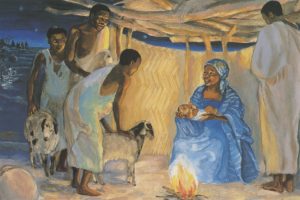My neighborhood in Houston, Texas, takes the holiday season seriously. Arches cross over the streets. Houses compete for wattage to power Christmas or Hanukkah lights.  A baby Jesus can be seen on almost every corner: Jesus in plastic and Jesus in painted wood; Jesus held by Mother Mary and Jesus lying in the hay.
A baby Jesus can be seen on almost every corner: Jesus in plastic and Jesus in painted wood; Jesus held by Mother Mary and Jesus lying in the hay.
One thing these neighborhood versions of the Christ-child have in common is their coloring. Every Jesus is white. Some even have blond hair. I wonder how things would be different if our modern renditions of Jesus made him look like the Middle Eastern Jew he was.
I think of my friend Nafisa. She wears a hijab. Nafisa looks to me the way I imagine Mary might have looked, especially when she wears light blue. Every picture of the manger scene I saw as a child had Mary with a light blue head covering. Nafisa was leery of becoming friends with me. Her experience of Christians, and Baptists in particular, has not been positive.
The first time I met her was at an interfaith gathering. I explained that I am a Baptist minister. She confronted me: “I know many Baptists. Christians talk a lot about this Jesus and his love, and then these same people are evil to me. You see my hijab. Just this week at Target a man saw me walking into the store and waited on me. As I came inside the doors he began to yell at me, calling me trash and filth, telling me to leave. He spat at me. Is this the love of your Jesus?”
“What if the sins Jesus saves us from don’t have anything to do with gender identity, sexual preferences, race or class?”
Her words filled me with shame: my shame that anyone would treat her so cruelly; shame that her perception of Christians, of Baptists, of me, was of people who talk about love and then spit on Muslims. I wanted to close my eyes and shut out the horror of her words and her experiences. Instead, I held her gaze and apologized. I said how sad I was that anyone would be so cruel. I said she was right that Jesus did teach love and that I couldn’t understand how people who claimed to follow him could be so dehumanizing. I said I was sad, that I was sorry and that I wanted her to be safe and to feel welcome.
I wonder if such mistreatment, hatred and violence would happen, especially in this time of year, if we had a more realistic image of Jesus. I don’t know that it would solve everything, but if the man who attacked Nafisa had noticed that she looks more like Jesus’ mother than his own mother likely does and that Nafisa’s young son looks more like Jesus than his own child does, could he hate her? If we put a dark-skinned Mary, Joseph and Jesus on our Christmas cards, coffee cups and front-yard manger scenes, would it change anything?
Ann Belford Ulanov in Picturing God tells us that without intentional intervention, children in our culture image God as an old white man. This image reigns unchecked unless it is countered with other God images. The idea that God is an old white man is reinforced by our images of Jesus. The vast majority of the artistic renderings of Jesus seen by most Americans depict him with pale skin, light brown hair and often blue eyes. You only need to think of the paintings, movies, TV mini-series and stained glass windows you have seen to know this is true.
As BNG opinion contributors Alicia Reyes-Barriéntez and Greg Jarrell have noted, many of us, without conscious intention or awareness, have become disciples of a white Jesus. Not only is white Jesus inaccurate, he also distorts our connections to the stories of Jesus and the stories of people of color.
Scholars and theologians debate about just how dark Jesus of Nazareth’s skin was. Princeton biblical scholar James Charlesworth notes Jesus was “most likely dark brown and sun-tanned” (The Historical Jesus: An Essential Guide, 2008). The late theologian James Cone wrote: “The ‘raceless’ American Christ has a light skin, wavy brown hair, and sometimes – wonder of wonders – blue eyes. For whites to find him with big lips and kinky hair is as offensive as it was for the Pharisees to find him partying with tax-collectors. But whether whites want to hear it or not, Christ is black, baby, with all of the features which are so detestable to white society” (Black Theology and Black Power, first published in 1969).

JESUS MAFA. The birth of Jesus with shepherds, from Art in the Christian Tradition, a project of the Vanderbilt Divinity Library, Nashville, TN.
While shades of brown are debated, it is clear that Jesus was not white. The earliest depictions of an adult Jesus showed him with a brown complexion. But by the sixth century, some Byzantine artists started picturing Jesus with white skin, a beard and light hair parted down the middle. This image became the standard.
In the colonial period, Western Europe exported its image of a white Christ worldwide, and white Jesus often shaped the way Christians understood Jesus’ ministry and mission. Some 19th-century Christians, eager to justify the cruelties of slavery, went out of their way to present Jesus as white. By negating his true identity as a dark-skinned, oppressed minority, slaveholders were better able to justify the master-slave hierarchy and forget Jesus’ ministry to set the oppressed free (Luke 4:18).
Our dominant, white Christian culture has white-washed Jesus. Instead of expanding our understanding of those who are different from us (including many who in fact look more like Jesus than we do), we have replaced them and their stories with a light brown-haired, blue-eyed lie.
We didn’t stop at white-washing, though. Not only was Jesus not white, he was also, as a Jew, part of a religious and ethnic minority in the Roman Empire. Jews were marginalized by Romans, Greeks and other non-Jewish groups in many imperial cities. As an infant, Jesus was the target of ruler-sanctioned violence and his family fled to Egypt as refugees. Joseph and Mary fled because of the gender of their firstborn. The lives of Jewish boys under age two were threatened by the empire. Jesus was a dark-skinned, religious-minority refugee whose family fled persecution because of his gender.
“Some 19th-century Christians, eager to justify the cruelties of slavery, went out of their way to present Jesus as white.”
The story of the birth of Jesus as it’s recorded in the Bible also comes with a significant amount of sexual scandal. In the genealogy that begins the Gospel of Matthew and leads directly to the Christmas story, Tamar appears. Tamar disguised herself as a prostitute in order to conceive a child with her father-in-law, Judah, in a desperate attempt at justice and security. Rahab is the next woman listed, and while she saved the Jewish spies and was crucial in the campaign to obtain the promised land, she is most remembered for being a prostitute. Ruth is named. She seduced her way into marriage and security in order to care for her mother-in-law, Naomi. Bathsheba is not named but is listed as the wife of Uriah. King David “took” Bathsheba and then plotted to have her husband, Uriah, murdered. The last woman mentioned in the genealogy of Jesus is Mary. Mary was pregnant before the wedding.
Jesus in the popular imagery of America’s white religious culture – the light-haired, blue-eyed, untainted, popular evangelist – bears almost no resemblance to the stories about Jesus in the Bible. What we find in our sacred stories is a dark-skinned, dark-eyed, dark-haired Middle Eastern child born amid sexual scandal; ostracized for his family’s religion; persecuted because of his gender; friend to tax collectors, prostitutes, sinners and other outcasts; who grew up in Nazareth. “Can anything good come out of Nazareth?”
How would Nafisa experience Christians if those Christians saw a manger scene on every corner with dark-skinned refugees? If, as Christians sang “Silent Night,” they remembered that Jesus with his parents fled from the Middle East to Africa in order to escape persecution for Jesus’ gender, could they really say hate-filled words about, and advance unfair and cruel treatment of, LGBTQ persons? Would racism continue and, in many places, now thrive if those who hate people for no reason beyond their skin tone knew we follow a black Christ?
“She will bear a son, and you are to name him Jesus, for he will save his people from their sins,” Matthew and Luke tell us.
“While shades of brown are debated, it is clear that Jesus was not white.”
What if the sins Jesus saves us from don’t have anything to do with gender identity, sexual preferences, race or class? Or, actually, what if they have everything to do with those distinctions? What if Jesus embodies the groups that are so often marginalized and oppressed? What if Jesus embodies refugee, religious minority, dark skin, poverty, sexual scandal and persecution for gender identity? What if Jesus saves us from our sins of racism, classism and Islamophobia and other forms of xenophobia?
What if the saving grace of Jesus is meant to deliver us from the hell we create with our hate?
